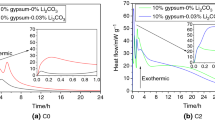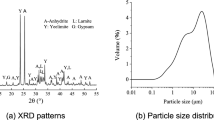Abstract
Calcium sulphoaluminate cement (CSA) has excellent anti-chloride penetration performance; therefore, a straight substitution of CSA for Portland cement to conduct marine engineering construction will significantly reduce the adverse effects of chloride ions (Cl−) on marine resource utilisation. Recent studies have focused on the chloride binding capacity, but relatively few investigations have examined the effects of Cl− on CSA. In this study, the effects of premixed Cl− on CSA properties were studied by setting time, hydration heat, linear shrinkage, and compressive strength. In addition, the mechanism of the chloride binding ability of CSA was analysed and explained using automatic potentiometric titration, X-ray diffraction, thermogravimetric analysis, and mercury intrusion porosimetry. The results showed that Cl− reduces the setting time and accelerates the hydration process of CSA cement. Cl− can improve the internal pore structure of materials at a water/binder ratio (w/b) of 0.5. The excellent chloride binding ability of CSA, owing to the formation of Kuzel’s salts or Friedel’s salts, was interpreted by the binding of Cl− and the synthesised hydration product, i.e., monosulphoaluminate (AFm).











Similar content being viewed by others
References
Chen J, Jiang Y, Chen J (2016) Study on the curing behavior of chloride ion in sea sand concrete. In: 2016 International forum on energy, environment and sustainable development. Atlantis Press, pp 301–306. https://doi.org/10.2991/ifeesd-16.2016.52
Sun W, Jiang Y, Liu JZ (2014) Analysing the micro structure of sea sand concrete. AMM 584–586:1076–1080. https://doi.org/10.4028/www.scientific.net/amm.584-586.1076
Yin S, Liu Z, Dong P (2022) Study on degradation of mechanical properties of BFRP bars wrapped with seawater sea sand concrete under chloride dry wet cycle. Constr Build Mater 352:129050. https://doi.org/10.1016/j.conbuildmat.2022.129050
Shi ZG, Geiker MR, Lothenbach B, Weerdt KD, Garzón SF, Enemark-Rasmussen K, Skibsted J (2017) Friedel’s salt profiles from thermogravimetric analysis and thermodynamic modelling of Portland cement-based mortars exposed to sodium chloride solution. Cem Concr Compos 78:73–83. https://doi.org/10.1016/j.cemconcomp.2017.01.002
Loser R, Lothenbach B, Leemann A, Tuchschmid M (2010) Chloride resistance of concrete and its binding capacity - Comparison between experimental results and thermodynamic modeling. Cem Concr Compos 32(1):34–42. https://doi.org/10.1016/j.cemconcomp.2009.08.001
Jones MR, Dhir RK, Magee BJ (1997) Concrete containing ternary blended binders: resistance to chloride ingress and carbonation. Cem Concr Res 27(6):825–831. https://doi.org/10.1016/S0008-8846(97)00075-6
Bi H, Zhang W, Xu X, Ming A, Shen Y, Wang S, Cheng X (2021) Chloride binding and transport characteristic of phosphoaluminate cement-based marine sand coating subjected to marine environment. Constr Build Mater 281:122505. https://doi.org/10.1016/j.conbuildmat.2021.122505
Li S, Jin Z, Yu Y (2021) Chloride binding by calcined layered double hydroxides and alumina-rich cementitious materials in mortar mixed with seawater and sea sand. Constr Build Mater 293:123493. https://doi.org/10.1016/j.conbuildmat.2021.123493
Liu W, Li Y, Tang L, Xing F (2021) Modelling analysis of chloride redistribution in sea-sand concrete exposed to atmospheric environment. Constr Build Mater 274:121962. https://doi.org/10.1016/j.conbuildmat.2020.121962
Pardal XL, Pochard I, Nonat A (2009) Experimental study of Si–Al substitution in calcium-silicate-hydrate (C-S-H) prepared under equilibrium conditions. Cem Concr Res 39(8):637–643. https://doi.org/10.1016/j.cemconres.2009.05.001
Plusquellec G, Nonat A (2016) Interactions between calcium silicate hydrate (C-S-H) and calcium chloride, bromide and nitrate. Cem Concr Res 90:89–96. https://doi.org/10.1016/j.cemconres.2016.08.002
Shi ZG, Geiker MR, Weerdt KD, Østnor TA, Lothenbach B, Winnefeld F, Skibsted J (2017) Role of calcium on chloride binding in hydrated Portland cement–metakaolin–limestone blends. Cem Concr Res 95:205–216. https://doi.org/10.1016/j.cemconres.2017.02.003
Glasser FP, Zhang L (2001) High-performance cement matrices based on calcium sulfoaluminate–belite compositions. Cem Concr Res 31(12):1881–1886. https://doi.org/10.1016/S0008-8846(01)00649-4
Yuan Q, Shi CJ, Schutter GD, Audenaert K, Deng DH (2009) Chloride binding of cement-based materials subjected to external chloride environment—a review. Constr Build Mater 23(1):1–13. https://doi.org/10.1016/j.conbuildmat.2008.02.004
Renaudin G, Kubel F, Rivera JP, Francois M (1999) Structural phase transition and high temperature phase structure of Friedels salt, 3CaO·Al2O3·CaCl2·10H2O. Cem Concr Res 29(12):1937–1942. https://doi.org/10.1016/S0008-8846(99)00199-4
Birnin-Yauri UA, Glasser FP (1998) Friedel’s salt, Ca2Al(OH)6(Cl, OH)·2H2O: its solid solutions and their role in chloride binding. Cem Concr Res 28(12):1713–1723. https://doi.org/10.1016/S0008-8846(98)00162-8
Péra J, Ambroise J (2004) New applications of calcium sulfoaluminate cement. Cem Concr Res 34(4):671–676. https://doi.org/10.1016/j.cemconres.2003.10.019
Kalogridis D, Ch KG, Ftikos Ch, Malami Ch (2000) A quantitative study of the influence of non-expansive sulfoaluminate cement on the corrosion of steel reinforcement. Cem Concr Res 30(11):1731–1740. https://doi.org/10.1016/S0008-8846(00)00277-5
Berger S, Coumes CCD, Bescop PL, Damidot D (2011) Stabilization of ZnCl2-containing wastes using calcium sulfoaluminate cement: cement hydration, strength development and volume stability. J Hazard Mater 194(5):256–267. https://doi.org/10.1016/j.jhazmat.2011.07.095
Mesbah A, Cau-dit-Coumes C, Renaudin G, Frizon F, Leroux F (2012) Uptake of chloride and carbonate ions by calcium monosulfoaluminate hydrate. Cem Concr Res 42(8):1157–1165. https://doi.org/10.1016/j.cemconres.2012.05.012
Sharp ZD, Barnes JD (2004) Water-soluble chlorides in massive seafloor serpentinites: a source of chloride in subduction zones. Earth Planet Sci Lett 226(1–2):243–254. https://doi.org/10.1016/j.epsl.2004.06.016
Younis A, Ebead U, Suraneni P, Nanni A (2018) Fresh and hardened properties of seawater-mixed concrete. Constr Build Mater 190:276–286. https://doi.org/10.1016/j.conbuildmat.2018.09.126
Ann KY, Cho CG (2014) Corrosion resistance of calcium aluminate cement concrete exposed to a chloride environment. Materials 7(2):887–898. https://doi.org/10.3390/ma7020887
Florea MVA, Brouwers HJH (2012) Chloride binding related to hydration products: part I: ordinary portland cement. Cem Concr Res 42(2):282–290. https://doi.org/10.1016/j.cemconres.2011.09.016
A.S.T.M. Standard, C191 (2021) Standard test methods for time of setting of hydraulic cement by Vicat Needle. ASTM International, West Conshohocken
Wadsö L (2005) Applications of an eight-channel isothermal conduction calorimeter for cement hydration studies. Cem Int 5:94–101
BS EN 196-1 (2005) Methods of testing cement.
Castellote M, Andrade C (2001) Round-Robin test on chloride analysis in concrete—part I: analysis of total chloride content. Mater Struct 34(9):532–549. https://doi.org/10.1007/BF02482181
Castellote M, Andrade C (2001) Round-robin test on chloride analysis in concrete—part II: analysis of water-soluble chloride content. Mater Struct 34(10):589–596. https://doi.org/10.1007/BF02482124
Beretka J, Marroccoli M, Sherman N, Valenti GL (1996) The influence of C4A3S content and ratio on the performance of calcium sulfoaluminate-based cements. Cem Concr Res 26(11):1673–1681. https://doi.org/10.1016/S0008-8846(96)00164-0
Yang Z, Ye H, Yuan Q, Li B, Li Y, Zhou D (2021) Factors influencing the hydration, dimensional stability, and strength development of the OPC-CSA-anhydrite ternary system. Mater 14(22):7001. https://doi.org/10.3390/ma14227001
Gallucci E, Zhang X, Scrivener KL (2013) Effect of temperature on the microstructure of calcium silicate hydrate (C-S-H). Cem Concr Res 53:185–195. https://doi.org/10.1016/j.cemconres.2013.06.008
Telesca A, Marroccoli M, Pace ML, Tomasulo M, Valenti GL, Monteiro PJM (2014) A hydration study of various calcium sulfoaluminate cements. Cem Concr Comp 53:224–232. https://doi.org/10.1016/j.cemconcomp.2014.07.002
Ipavec A, Vuk T, Gabrovšek R, Kaučič V (2013) Chloride binding into hydrated blended cements: the influence of limestone and alkalinity. Cem Concr Res 48(2):74–85. https://doi.org/10.1016/j.cemconres.2013.02.010
Rumelhard G (1987) Formation, modification et dissolution du concept d’hormone dans l’enseignement. Aster Recherches en Didactique des Sciences Expérimentales 5(1):143–170. https://doi.org/10.4267/2042/9234
Paul G, Boccaleri E, Buzzi L, Canonico F, Gastaldi D (2015) Friedel’s salt formation in sulfoaluminate cements: a combined XRD and 27Al MAS NMR study. Cem Concr Res 67:93–102. https://doi.org/10.1016/j.cemconres.2014.08.004
Baquerizo LG, Matschei T, Scrivener KL, Saeidpour M, Wadsö L (2015) Hydration states of AFm cement phases. Cem Concr Res 73(24):143–157. https://doi.org/10.1016/j.cemconres.2015.02.011
Wang YC, Jiang XL, Zhong ZH, Liu ZC (2022) Binding mechanism of CSA cement on premixed Cl− and its governing parameters. J Mater Civ Eng 34(2):04021429. https://doi.org/10.1061/(ASCE)MT.1943-5533.0004066
Mesbah A, François M, Cau-dit-Coumes C, Frizon F, Filinchuk Y, Leroux F, Ravaux J, Renaudin G (2011) Crystal structure of Kuzel’s salt 3CaO·Al2O3·1/2CaSO4·1/2CaCl2·11H2O determined by synchrotron powder diffraction. Cem Concr Res 41(5):504–509. https://doi.org/10.1016/j.cemconres.2011.01.015
Glasser FP, Kindness A, Stronach SA (1999) Stability and solubility relationships in AFm phases: part I. Chloride, sulfate and hydroxide. Cem Concr Res 29(6):861–866. https://doi.org/10.1016/S0008-8846(99)00055-1
Acknowledgements
The authors would like to appreciate the financial support provided by the National Natural Science Foundation of China (Nos. 52078301 and 52178235) and Shenzhen Natural Science Fund (JCYJ20220531101415036 and 20220811100052001). Technical support is acknowledged from Guangdong Provincial Key Laboratory of Durability for Marine Civil Engineering (SZU), No. 2020B1212060074.
Author information
Authors and Affiliations
Corresponding author
Ethics declarations
Conflict of interest
No conflict of interest exits in the submission of this manuscript, and manuscript is approved by all authors for publication. I would like to declare on behalf of my co-authors that the work described was original research that has not been published previously, and not under consideration for publication elsewhere, in whole or in part. All the authors listed have approved the manuscript that is enclosed.
Additional information
Publisher's Note
Springer Nature remains neutral with regard to jurisdictional claims in published maps and institutional affiliations.
Rights and permissions
Springer Nature or its licensor (e.g. a society or other partner) holds exclusive rights to this article under a publishing agreement with the author(s) or other rightsholder(s); author self-archiving of the accepted manuscript version of this article is solely governed by the terms of such publishing agreement and applicable law.
About this article
Cite this article
Wang, X., Jiang, X., Wang, Y. et al. Effects of premixed Cl− on performance of calcium sulphoaluminate cement: mechanism of anti-chloride penetration. Mater Struct 56, 127 (2023). https://doi.org/10.1617/s11527-023-02214-9
Received:
Accepted:
Published:
DOI: https://doi.org/10.1617/s11527-023-02214-9




